Reading Recommendations
Reviewed by Joli Forbes and Ashley Ess
All titles are available for purchase in the Bamboo Shop
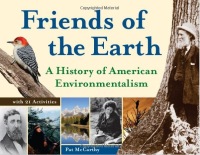
Friends of the Earth: A History of American Environmentalism
by Pat McCarthy
Friends of the Earth is as fun and engaging as it is inspirational and informative. Creative and scientific projects are interspersed with historical accounts of conservationists, environmentalists and even authors and artists, telling of their dedication to insuring that future generations have protected lands to enjoy and a safe environment to live in. The stories of determined men and women like John Muir, Rachel Carson and Henry David Thoreau in such a context can reach inside the psyche of a child to instill reverence for the act of helping to preserve our environment.
A wonderful resource for educational activities as well as the history of environmentalism, with Friends of the Earth children can learn how to compost, plant a tree, build bird feeders, test for acid rain and much more. They will also learn of some wonderful spots across the U.S. to visit, like National Parks and Preserves as well as Wildlife Refuges, with a perk being that they will have studied the vast history and about those who strived to protect these places, lending a deeper appreciation of the importance of our environment.
Friends of the Earth is such a great find because it delves even deeper into the Earth Day consciousness, which often wanes as the year moves along. Sometimes learning what others have sacrificed and are bravely doing to keep our planet healthy and beautiful is what it takes to encourage us to create a lifelong determination to do our part.
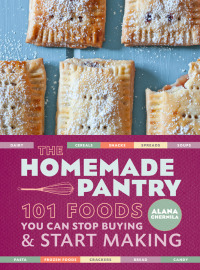
The Homemade Pantry: 101 Foods You Can Stop Buying and Start Making
by Alana Chernila
Mother, Renaissance woman, and all around farm-to-table expert, author Alana Chernila has taken her vast and full-of-knowledge life and written us a book! This book helps us unlearn the advertising plan administered in sound bites to us that “individually wrapped is better” and reminds us that all the processed foods we’re pumping into our kids lunches are UNNECESSARY! We can make better versions from home.
Homemade Pantry offers homemade recipes for canning, fermenting, baking, and dehydrating. Learn how to make yogurt, crackers, candy, bread and condiments … and many other things found in lunchboxes full of wrappers that landfills don’t need or want! There are also instructions for freezing farm veggies, making peanut butter cups and homemade Twinkies! Something for everyone!
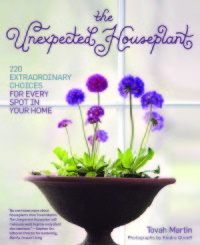
The Unexpected Houseplant: 220 Extraordinary Choices for Every Spot in Your Home
by Tovah Martin
She says as a child she brought home a dying ivy plant, and author Tovah Martin brought it back to life beginning her lifelong obsession with plants. Her East Coast home is completely covered with plant life and in her eighth book, The Unexpected Houseplant, Martin tells us what plants can finally come inside and make our homes breathe with color and life.
Organized into seasons, (as most plant how-to books should be!), the book offers stories of her experience, scientific info on 220 plants that can live inside (at least most of the time), plus you'll get some tricks of the craft. Did you know that you can make bulbs grow flowers right on your coffee table? Did you know you can grow orange trees inside?
Beautiful photos by Kindra Clineff and wonderful ideas are finalized by a super helpful source list for plants and equipment discussed, all within the 326-page softback that aims to bring the green thumb out from the dark corners of our houses.
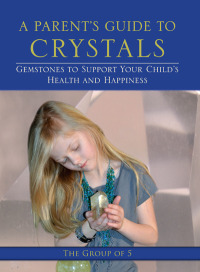 A Parent's Guide to Crystals: Gemstones to Support Your Child's Health and Happiness
A Parent's Guide to Crystals: Gemstones to Support Your Child's Health and Happiness
by The Group of 5
This book is unique and full of wisdom. A Parent’s Guide to Crystals talks about children’s ability to understand the mineral world clearer than adults because “they haven’t raised mental barriers”; the energies and intelligences within the stones are more easily connected to the energies of the children in our lives. So though the expert authors wrote this book for children, the earth medicine in the stones can be used for adults as well.
The book shares knowledge about purchasing, caring for and recharging stones as well as how to create stone and crystal elixirs and therapy. The book is then organized into stages of life: Early Childhood, The School Years, Adolescence and Beyond and then finally “Crystal Therapy for Specific Circumstances.” Within each section there are about 10 or so issues associated with that time of life and the stones that would be useful to work out the issue.
For the novice, the index is supreme! A photo log of each of the discussed stones spans 8 pages and is followed by an index titled, “Suggested Stones and Crystals by Subject.”
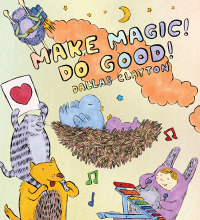 Make Magic! Do Good!
Make Magic! Do Good!
by Dallas Clayton
A wonderful man with pink hair, John Styn, is the sole online speaker for the Hug Nation’s weekly live broadcasts (Tuesdays at 1pm & 6pm). The messages of this site are about recalibrating “your heart and align(ing) yourself with a communal Love Vibration!” My family and I are big fans.
One time, while cruising around his website, I came across a review of Make Magic! Do Good! by Dallas Clayton and I just had to get my hands on it. I’m sooooooo glad I did.
Adventure enthusiast and artistically inclined do-good papa, Dallas Clayton, has written three books now… collections of children’s poems that he also adorably illustrates and their messages are amazing.
There is one about a boy who learns that changing with age is better than always staying the same, and one about realizing your enemies like the same cool stuff you do if you give ‘em a chance and call ‘em friends. There are poems about moving forward after making mistakes, waking up your brain, humility, robots and dragons. This is definitely a Bamboo Favorite!!!
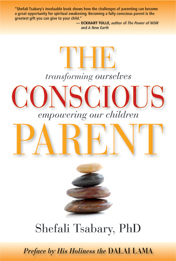
The Conscious Parent:
Transforming Oursleves, Empowering Our Children
by Shefali Tsabary
Consciously raising children means learning, changing, teaching and being aware. There has never been, nor will there ever be, a perfect parent, for perfection is not an aspect of the human condition. We all make mistakes everyday.
My dad always tells me, “It is a wise person who can forgive their parents and accept that they did the best they could with what they had.”
So, if you seek to parent with higher consciousness than that which has been ingrained into your psyche from your childhood, you’ll need teachers and texts to guide you through this ongoing process of change. The Conscious Parent is one of those texts.
Accepting our children for who they are, not what they do… realizing some moments are just about their spirit, not about teaching them right and wrong—these are just some of the very powerful messages in Shefali Tsabary’s book that will forever remain in my reference library.
Dr. Tsabary is a Clinical Psychologist with a doctorate from Columbia and she mixes her knowledge of Eastern Philosophy with Western Science creating a conjoined ideology filled with logical, sound, loving and understanding visions for conscious parenting.
Accolades from Marianne Williamson and Echkart Tolle plus a preface written by the Dalai Lama are telling signs that this 251 page softback is a powerful read. Dr. Tsabary has created a conscious parent’s owner’s manual with strong and penetrating chapter titles like “The Spiritual Reasons We Birth Our Children,” “Parent From Wholeness Instead of Your Wounds,” and “The Wonder of the Ordinary.” A Bamboo Favorite!
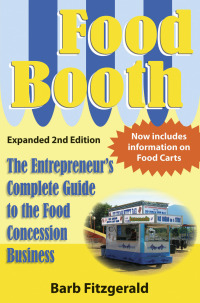
Food Booth
by Barb Fitzgerald
This book is a How-To text about starting a food booth and or food vending business. It has been my lifelong dream to own and run a festival food booth so this title struck my fancy quickly. As a stay-at-home mom, finding ways to contribute financially that also fulfill a nurturing professional purpose that only take me away from home for short periods of time sounds like a rewarding path for a woman like me.
Author Barb Fitzgerald is an expert in this field. She claims that this is not a “get-rich-quick” path, but rather a lifestyle choice that only works for some. Feeling comfy with carnies, working hard and getting dirty is not for everybody and she begins the book with a few sections that ask you to look deep into your intentions and decide what your exact goals are and what type (if any) of food vending business would be best for you.
Business plans are both exciting and tedious. She walks you through goal sheet creation, business blueprint mapping, permits and licensing procedures, business management, sales and financial recording. The appendixes are extremely helpful including a list of familiar fair foods, sample applications and forms and financial documents like Profit and Loss Statements and Monthly Expense Logs. Then she provides you with equipment vendor contact info plus fair association and small business references to help get you connected.
A 25-year veteran of this industry, Fitgerald has worked hundreds of events, chaired committees on the subject and run the gamut of experiences that she openly shares in this book that can be found on her also very informational website http://www.foodbooth.net/.
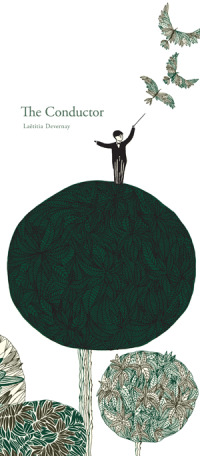
The Conductor
by Laetitia Devernay
This is an illustrated novel with a dichromatic color scheme and the unassuming story of nature’s yearly regeneration. The artsy pages of The Conductor are wordless leaving the storytelling up to the “readers.” Forest-y/sage-y dark green and washed out yellow drawings illustrate the story of a human orchestral conductor who climbs a tall tree in an orchard to bring the changing of the seasons.
A wave of his wand and all the leaves fly into their air, swirling and whirling into birds and take flight into dancing formations that soar together high above their leader’s wand. The humble conductor takes a bow when the trees are bare and as he descends the wooded wonder some of the birdlike fronds slowly return to their arboreal perch.
When the conductor makes it back to the ground he is found planting a new tree. Without insight on the author’s intent, a child—without a jaded notion about man’s roles in the death of nature or responsible actions in the forest—a kid can make up their own story about this soft and evergreen narrative.
It’s hard to say what age this book is for, because it’s a bit high-art for young ones, in fact my 5-year-old found no interest in it at all. However I think this would be a great gift for the gifted child who thrives within imagination.
Moosewood Cooks for a Crowd
by The Moosewood Collective
I became a vegetarian at the age of 15 and that was quite a while ago! Back then there were very few veggie cookbooks that used any flavor! It was as if “conscious” and “healthy” actually meant “bland” and “boring” in some weird cosmic vortex! The Moosewood Collective was my salvation because they have been prolifically producing cookbooks since 1973 that are internationally focused and full of internationally inspired deliciousness!
Moosewood Cooks for a Crowd is a rare print, and a perfect gift for intermediate chef who loves to feed groups of people. This chef must also not be afraid to stray from the book to add pizazz because some of the ingredients are outdated and vast improvements to grocery store and specialty store inventories have happened since the book was published.
(This book is not a great choice for vegans (though there are some recipes without dairy) but rather, it’s for gatherings where vegetarian and/or pescatarian palettes frequent!)
Each recipe is written for 25 servings or more with pre-calculated nutrition and ingredients lists. The ingredients are measured in volume and/or weight and the appendixes list average waste weight versus edible food matter so you can shop accordingly.
Recipes like Spicy Chick-Peas, French Ragout, Mole with Cornbread and Creole Beans and Rice fill the pages and sound delicious—though there were a few online reviews that made them sound bland… my biggest fear, so I tried one myself!
After making the Pasta Primavera recipe I surmised that this book is written for people who have access to a commercial kitchen or who have large (like gallon) measuring devices, ample washing and fridge space and who aren’t afraid to add personal flair. So use the pages for reference and make the deliciousness your own.
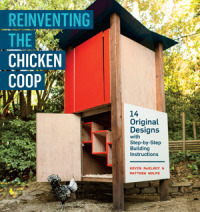
Reinventig the Chicken Coop
by Kevin McElroy & Matthew Wolpe
My neighbors built their own chicken coop. Every store bought, pre-fab design they found was not right for this or that reason and they decided to build their own. Every weekend the husband would be “going back to the drawing board” and going back to the home improvement store because his design was evolving as he worked. This book would have solved that problem!
Reinventing the Chicken Coop contains 14 original designs with simple instructions for building that are arranged from easy to difficult. A complete materials list, architectural drawings and color photos make this a must-have resource for budding sustainable egg eaters!
There are amazing design ideas, like building a 4-ish tiered sitting stair that is meant to both keep chickens happy and double as a place for friends and family to sit during gatherings.
While admittedly I did not build one to test the designs and instructions (I’m moving next week!), I absolutely plan on it just as soon as I can convince my husband the smell and noise of keeping chickens is not a problem. Any suggestions would be more than appreciated!

A Handful of Quiet: Happiness in Four Pebbles
by Thich Nhat Hanh
Meditation is an inward journey that can transform perspectives or at minimum suggest we live quietly for long enough to bring about calm. Meditation is not just for us “hippies” anymore… it has become a daily requirement at some prisons and forward-thinking rehab facilities and it is the regular daily practice of famous and highly productive individuals like filmmakers Richard Gere and David Lynch, and chanteuses Alanis Morissette and Erykah Badu.
I am neither highly productive nor a prisoner, haaa, and I aspire to meditate everyday. It is my highest intention to maintain a regular practice and so I am always seeking out new ways to make this age-old practice suit my daily schedule.
One of my meditation teachers, Noah Levine, founded The Against the Stream Medication Society. In his meditation class I learned of this gentle book’s author, Thick Nhat Hanh. He is a living guide in the Buddhist community and a prolific author. This book teaches about Pebble Meditations where each of four pebbles you hold in your hand and eventually sit next to you while meditating represents four elements in nature: flower, mountain, calm water and space.
It is a small, pastel blue book with a massive message told with a whisper. Soothing illustrations, a short read, and journaling and drawing space make this a wonderful gift for just about anybody!

Child's Mind: Mindfulness Practices to Help Our Children Be More Focused, Calm, and Relaxed
by Christopher Willard
My husband and I took a class at Against the Stream Buddhist Meditation Center once. The class was called “Intro to Mindful Meditation.” In brief summation, we learned how to focus within, concentrate on the big picture inside and notice thoughts, feelings and bodily going-ons that occurred during a sit. We discussed meditation as a means toward deeper concentration, thinking, and calmness.
Oh how my kid could use that!
So I found Child’s Mind: Mindfulness Practices to Help Our Children Be More Focused, Calm, and Relaxed by Christopher Willard. In the short and easy to read text we find practical exersizes to incorporate meditation into the lives of our children. There are many kinds of mindfulness practices outlined in the book including magic cloud disappearing, eating, hugging, walking, belly dancing and Capoiera meditations because mindfulness is a way of being; a way to be focused calm and relaxed in every opportunity should we know how and be willing.
The book teaches us how to teach our kids so they have the tools to face their demons and the demons of the world with clarity and grace.
“Mind your space,” I tell my 5-year-old after taking the Mindful Meditation class. Then I wonder, does she know what I mean? So I ask her in a calm moment and she replies, “Mind your space cuz there are a lot of people around and I don’t want to bump into them.” Maybe she gets it…
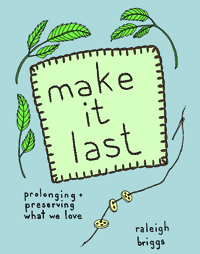
Make It Last:
Prolonging & Preserving What We Love
by Raleigh Briggs
Fixing zippers, waterproofing, canning, drying herbs, mending seems and windowscreens… these are just some of the everyday activities we could all do to make things last longer and preserve their wonderfulness in our lives!
Raleigh Briggs has published yet another gem of a household reference book called, Make It Last: Prolonging & Preserving What We Love. It is a short, simple read that takes us back to basics… the info our Home Ec. classes would teach us if they still existed!
There is a wonderful section on storing produce that’s as full as a farm pantry at the end of summer. Did you know you can hang dry mushrooms like you would garlic? Do you know how to revive limp carrots and make herbal honeys? Do you know how to replace a toilet’s waxy ring or fix drafty windows?
If the answer was “no” then buy this book. It’s a keeper for anyone DIY oriented and who wants to save some money on repairs or replacements.
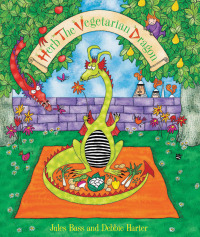
Herb the Vegetarian Dragon (Barefoot Books)
by Jules Bass & Debbie Harter
This is quite possibly the most adorable children’s book EVER! Co-produced by Debbie Harter and famed filmmaker/songwriter/and author Jules Bass, it’s no wonder that Herb the Vegetarian Dragon is so alive with life lessons, giant vocabulary words and glorious progressive thinking for young minds to ingest.
While the other dragons are hunting princesses and knights, Herb the vegetarian dragon has made friends with a village child while tending to his vegetable garden and his relationship to food and to community end up saving his life and the lives of the other dragons. Lush and bright illustrations by Debbie Harter add visual stimulus to this kindergarten-3rd grade storybook and there is an accompanying vegetarian children’s cookbook called, Cooking with Herb to help get kids thinking about eating their veggies and being vegetarian! A Bamboo Favorite for sure!!!
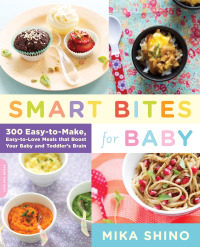
Smart Bites for Baby
by Mika Shino
The author of this nutritional recipe book has led a culinary dream life. Pulling from her Japanese background, Parisian formal training and around-the-world travels with the UN, Mika Shino teaches us how to prepare foods for babies and toddlers that maximize absorption of nutrients and stimulate the senses.
With an introduction by an approving mother and two forwards by two different doctors, this book reminds us that babies and toddlers not only can eat everything we eat but that they need these complex foods for brain power and for fueling their little, busy bodies.
Creamy Orzo with Shredded Crabmeat, Almond Gnocchi with Sage Brown Butter, Couscous with Beef, Onions and Raisins and Sweet Yam, and Lotus Root Treats are some of the revolutionary thinking going on in this delicious book—complete with a “What to Have in Your Pantry” appendix, and nutrition and feeding facts throughout.
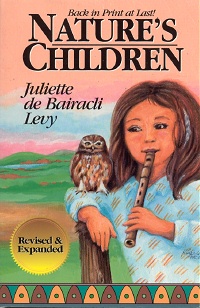
Nature’s Children
by Juliette de Bairacli Levy
Natural medicine, wildcrafted by the family might sound like fantasy in this day and age when it seems there are CVS pharmacies on every city block. So, in turn, wisdoms from those who came before, and who were wise enough to write them down have become invaluable…otherwise being lost in the shuffle. And this is one of those texts.
Renowned herbalist, natural veterinarian, and author Juliette de Bairacli Levy raised her two children among nomadic peoples and learned the ways of the land. This book (first published in 1970) tells her stories and passes along precious information regarding herbology, mother and child relationships, health and well-being.
There are history lessons, food recipes, recipes for naturopathy and herbology and a handful of period photos of her children with various animals such as her son’s pet owl. This revised and expanded edition is a must read for parents who crave the wisdom of a day passed and the ways of our human ancestors who lived with nature.
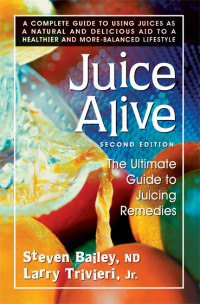
Juice Alive
by Steven Bailey, N.D. & Larry Trivieri, Jr.
Juicing is all the rage! Weightloss, cleansing, glowing from the inside-out… these are common understandings of the uses of raw fruits and vegetables these days. But this book takes things a step farther. This book talks about using juicing as a path toward optimal health and how to use juices, tonics and smoothies as a boost to the body's systems and to naturally heal more than 100 common ailments and imbalances within the human body.
These kinds of home remedy reference books last for generations but what good are they if the reader doesn’t have access to the ingredients called for in the recipes? Well this book solves that problem by offering an extensive resource list that includes juicer manufacturers, raw food and vegetarian organizations and support groups, nutritional products and online Community Supported Agriculture farms.
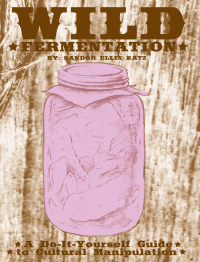 Wild Fermentation
Wild Fermentation
by Sandor Ellix Katz
The subtitle of this small and info-rich book is, “A Do-It-Yourself Guide to Cultural Manipulation.” GENIUS! American’s are suffering from yucky guts and this book teaches us how to fix ‘em … simple and basic!
By introducing intestinal flora in the form of fermented foods into our diet, we can attempt to heal our bellies, and in turn our brains and our immune systems, according to Grace Suh Coscia’s article in the Huffington Post:
“Intestinal flora impacts more than your gut: It also affects your immune and nervous systems. According to Dr. Joseph Mercola, almost 80 percent of your immune system exists in your gut, which contains about 100 trillion bacteria. If you want to put that into perspective, you have 10 times more gut bacteria than the number of cells in your whole body!”
Cheese, vinegar, tempeh, tofu, pickles, sour cream and kimchi are just some of the delicious and healthy recipes found in this book that we cannot recommend enough! Much like homesteading activities such as canning and curing, these kitchen community undertakings bring the village home and prove a great outlet for gathering friends and family while keeping everyone happy and healthy.
Being True to Life: Poetic Paths to Personal Growth
by David Richo, Ph.D.
This Shambhala publication is a poetic workbook for those with poetry in their heart and the will to expand their horizons. The introduction says it all, “This book is based on the captivating and delightful idea that writing a poem can be a powerful tool for self-discovery and healing.”
I have been a poet most of my conscious life, and I have taken poetry theory and practice classes for years. I think this text might contain some of the best explanations of poetry and how to understand it that I’ve seen. Author and therapist, David Richo, PhD uses spiritual, transpersonal, Jungian and mythic viewpoints to walk the reader through writing, healing and letting go… priceless!
All Me, All the Time
by Karla Oceanak (and you!)
The world’s first art-o-biography written by your kid… with a bit of sketching, photo input and personal details thrown in—A Bamboo Favorite! This is basically a baby book (full of favorites and firsts) but for big kids, written in the first person like a journal with many fill-in-the-blanks of the past, present and future with space for photos and places to sketch room layouts and paste pictures of their favorite friends. There are maps, time schedules, and art opportunities in the forms of a family crest shield and a color wheel that needs coloring.
This is one of many wonderful books written by the front woman and co-founder of Baliwick Press out of Fort Collins Colorado. Playful and silly at times, this “art”-o-biographic journal encourages kids to identify and conceptualize their ideas, desires and goals while practicing writing, sentence structure and essay concept—fun for the entire family! (Bamboo suggests taking some time to fill out the entire book with your child and then put it away for some time…remembering is part of the fun!)
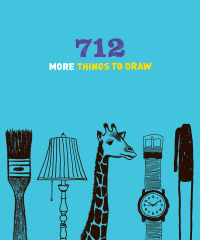 712 MORE THINGS TO DRAW
712 MORE THINGS TO DRAW
by Chronicle Books
My dad is a doodler. During his famous trial in 1975 he made such a beautiful swirling doodle in black ballpoint pen on a yellow, lined legal pad that it is currently framed in his office. My dad’s a thinker, and he doodles while he thinks.
712 MORE THINGS TO DRAW is the second in a series of books created for people just like my dad—for the artists and thinkers among us. A perfect gift for desk-bound doodlers like Bill Gates and genius Renaissance folks likes Leonardo di Vinci, 712 MORE THINGS TO DRAW is basically an empty book. Each page contains one or at most three simple phrases, such as “victory” and “a koala” and there is allotted space for doodling and/or drawing each specific drawing prompt.
Research has shown that certain types of learners called Haptic Learners best ingest information by utilizing their sense of touch or grasp (Institute for Learning Styles Research, 2003) and “…enjoy doing artwork, tracing words and pictures and will often be found doodling” according to Sandra E. Davis’ scholarly article, “Learning Styles and Memory” published by Auburn University.
This “inspirational sketchbook” will definitely by helpful to haptic learners as well as the rest of us who just want to exercise this passive, brain-power tactic.
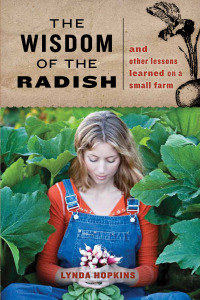 The Wisdom of the Radish
The Wisdom of the Radish
by Lynda Hopkins
Msnbc.com headline on Dec., 21st, 2011 reads, Stifled by Corporate America, the Young Turn to Farming: Despite its risks, farming is seen as a good bet as demand for organic produce rises.” Then starting in 2010 the documentary, Grow!, began winning award after award as it showed us, “…the energy, passion and independence of a fresh crop of young farmers.” Wisdom of the Radish is a young couple’s story of this journey.
A Stanford graduate, author Lynda Hopkins, finds herself in No. California as a farmer’s love and the story organically grows from there. This is the perfect book for those of us who harbor a dream to move back to nature and to quell our addiction to consumption as we get down and dirty and produce something of value instead—oh wait, that’s me!



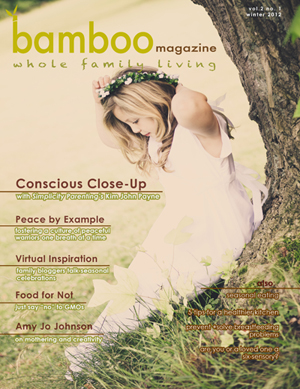

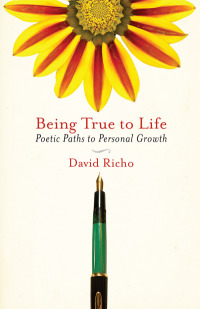
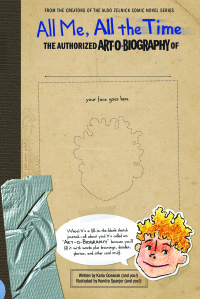
 Post a Comment
Post a Comment